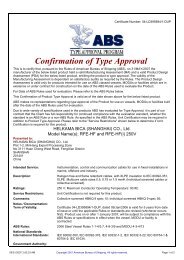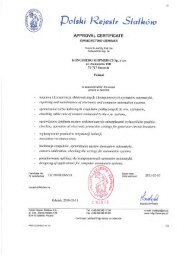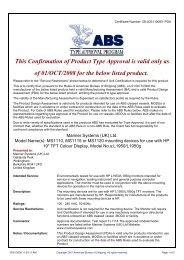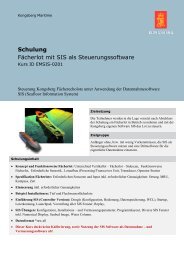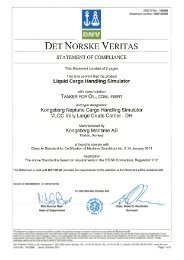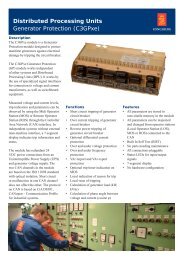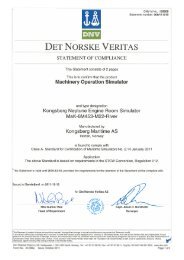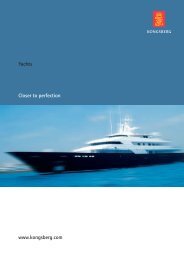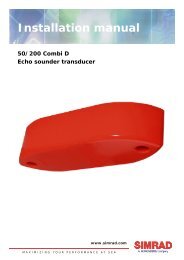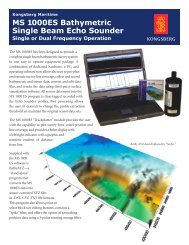No. 4 - December 2011 - Kongsberg Maritime
No. 4 - December 2011 - Kongsberg Maritime
No. 4 - December 2011 - Kongsberg Maritime
Create successful ePaper yourself
Turn your PDF publications into a flip-book with our unique Google optimized e-Paper software.
The SUBSEA NEWSLETTER page 3<br />
DECEMBER <strong>2011</strong><br />
NOAA and Partners demonstrated success of<br />
EM 302 Multibeam Echosounder to detect and<br />
map deep-sea gas seeps<br />
knowledge of the marine environment,<br />
including the distribution of natural<br />
sources of methane input into the ocean<br />
and the identification of communities of<br />
life that are often associated with methane<br />
gas seeps,” said Thomas Weber, Ph.D., of<br />
the University of New Hampshire’s Center<br />
for Coastal and Ocean Mapping and<br />
lead scientist of the mission.<br />
Multibeam sonar, an echo sounding<br />
technology commonly used to map the<br />
seafloor, can also be used to map and detect<br />
gaseous seeps in the water column,<br />
according to scientists testing the technology<br />
on board NOAA Ship Okeanos<br />
Explorer in the Gulf of Mexico.<br />
Following an earlier test in 2009 on<br />
Okeanos Explorer’s multibeam sonar<br />
off the U.S. West Coast, the most recent<br />
expedition in the Gulf was the first comprehensive<br />
test of Okeanos Explorer’s<br />
multibeam to detect deep gaseous seeps<br />
over a wide area. Its use during this mission<br />
confirms the effectiveness of the<br />
tool and may lead to extending NOAA’s<br />
water-column mapping capabilities.<br />
The expedition was conducted jointly<br />
by NOAA’s Office of Ocean Exploration<br />
and Research (OER), the University<br />
of New Hampshire’s Center for Coastal<br />
and Ocean Mapping and the Bureau of<br />
Ocean Energy Management, Regulation<br />
and Enforcement (BOEMRE), as well as<br />
scientists and technicians from NOAA’s<br />
Southeast Fisheries Science Center working<br />
in parallel from NOAA Ship Pisces.<br />
With the Gulf of Mexico home to numerous<br />
gaseous seeps, data collected by<br />
multibeam sonar could prove valuable to<br />
researchers planning further studies of<br />
gas seeps and their effects on the marine<br />
environment.<br />
The objective of the expedition was to<br />
test the sonar’s ability to map gaseous<br />
seeps, not oil, as oil is more difficult to<br />
acoustically detect with the multibeam<br />
sonar. Techniques developed during<br />
this cruise are intended to help scientists<br />
better understand detection of gas<br />
seeps which may in turn better inform<br />
scientists who are working on techniques<br />
to map oil in the water column.<br />
“This capability will help increase our<br />
“Mapping the seafloor and the water<br />
column are essential first steps in exploring<br />
our largely unknown ocean.<br />
This expedition confirms earlier indications<br />
that multibeam technology provides<br />
a valuable new tool in the inventory<br />
to detect plumes of gas in the water<br />
column, and especially in deep water,”<br />
added Weber.<br />
Bill Shedd, a BOEMRE geophysicist<br />
and expert in hydrocarbon seeps who<br />
participated in the expedition as part of<br />
an ongoing collaboration with NOAA’s<br />
OER, stated, “Our agencies have been<br />
working together in the Gulf of Mexico<br />
since 2003. We’re optimistic and impressed<br />
about this new capability for<br />
exploration that was demonstrated so<br />
well during this expedition.”<br />
An Update from South America<br />
Chile<br />
<strong>Kongsberg</strong> Maritme AS Hydrographic Departement has been awarded a<br />
contract by the Chilean Hydrographic and Oceanographic Service (SHOA) for<br />
the supply of new survey equipment for the hydrographic survey vessel PSH<br />
Cabrales. The supply consists of one EM 3002 Dual, one EM 710 1x2 one<br />
EA 400, sensors, spareparts and services. The plan is to have the equipment<br />
delivered and installed during the first half of 2012. We previously supplied<br />
EM 3002 systems to two of SHOA’s other vessels, the PSG Micalvi and PSG<br />
Ortiz, which are both in operation.<br />
Peru<br />
<strong>Kongsberg</strong> Maritme AS Hydrographic Departement has been awarded a<br />
contract by the Hydrographic Office in Callao, Lima, Peru (Direccion de<br />
Hidrografia y Navigacion - DHN) for the supply of one EM 3002 Dual, one<br />
Seapath 330, sensors and services. The equipment will be used for shallow<br />
water mapping and mapping of rivers and waterways. The system will be<br />
installed on DHN’s new shallow water survey vessel during the last part of<br />
<strong>2011</strong> and first half of 2012.




